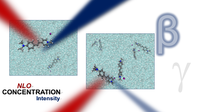Second harmonic generation responses of ion pairs forming dimeric aggregates
Frequently observed in liquid solutions, the aggregation effects can modulate the second- and third-order optical (NLO) responses due to induced global symmetry changes. To better understand this effect, we applied, for the first time, a sequential multiscale approach – combining molecular dynamics and density functional theory calculations – to unravel the dimerization effects on the second harmonic generation responses for a set of anion-cation pairs. Our simulations provided different structural shapes for dimers as stacked, L, and head-to-head ones, something hard to identify in experimental measurements.
 From the NLO point of view, the dimerization reduced the response by half for L-shaped and by only 10 % for stacked-shaped configurations, allowing deeper explanations about the concentration-dependence observed by Tessore1. Thereby, we demonstrated that a multiscale simulation is a great tool to better understand the NLO properties of anion-cation pairs in a liquid environment.
From the NLO point of view, the dimerization reduced the response by half for L-shaped and by only 10 % for stacked-shaped configurations, allowing deeper explanations about the concentration-dependence observed by Tessore1. Thereby, we demonstrated that a multiscale simulation is a great tool to better understand the NLO properties of anion-cation pairs in a liquid environment.
1 - F. Tessore, E. Cariati, F. Cariati, D. Roberto, R. Ugo, P. Mussini, C. Zuccaccia, A. Macchioni, ChemPhysChem. 11 (2010) 495–507.
Tárcius N. Ramos hold a postdoctoral position supported by “Fonds Spécial de Recherche of UNamur”. All calculations were performed on the computers of the “Consortium des Équipements de Calcul Intensif (CÉCI)” (http://www.ceci-hpc.be), including those of the “UNamur Technological Platform of High-Performance Computing (PTCI)” (http://www.ptci.unamur.be).


